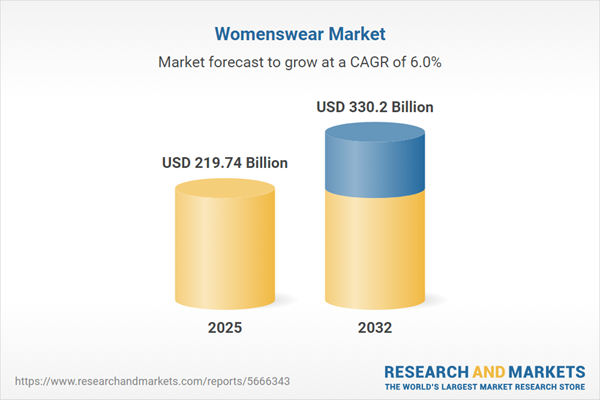Speak directly to the analyst to clarify any post sales queries you may have.
Senior leaders in the womenswear sector face an increasingly complex environment shaped by advancing technology, consumer behavior shifts, and evolving regulatory demands. Reliable, high-quality market research is essential to develop effective strategies that support growth, resilience, and advanced decision-making within this dynamic industry.
Market Snapshot: Womenswear Market Size, Growth, and Demand Trends
The global womenswear market is currently valued at USD 207.42 billion for 2024, with a projected increase to USD 219.74 billion in 2025 and an expected expansion to USD 330.20 billion by 2032. This market exhibits a compound annual growth rate of 5.98%, reflecting persistent momentum and robust sector health. Primary growth drivers include digital transformation across the industry’s sales channels and operations, supply chain innovation, and the rapid rise of alternative retail models. Increased investment in analytics allows organizations to anticipate shifts in consumer demand, while agile supply chain strategies and the adoption of advanced technologies enhance competitive positioning. Both well-established brands and innovative market entrants are deploying cutting-edge tools, intensifying the need for adaptable approaches.
Scope & Segmentation: Actionable Insights Across the Womenswear Value Chain
This report gives senior decision-makers clear segmentation and competitive intelligence covering the entire womenswear value chain, equipping organizations to craft precise strategies. The scope centers on the following key market dimensions:
- Distribution Channels: Analysis of digital, physical retail, and omnichannel models to optimize customer reach and facilitate engagement across touchpoints.
- Price Segments: Examination of Luxury, Mass Market, Mid Market, and Premium categories, vital for brand positioning and targeted audience strategies.
- Age Groups: Guidance on strategies for Adults, Seniors, Teens, and Young Adults, supporting product design tailored to unique demographic requirements and lifestyle preferences.
- Product Types: Comprehensive overview of Activewear, Bottoms, Dresses, Lingerie & Sleepwear, Outerwear, Swimwear, and Tops & Shirts, enabling timely portfolio adjustments as trends emerge.
- Occasions: Insight into Casual, Formal, Lounge, and Sports Wear trends, providing direction for product offerings that respond to evolving consumer lifestyles.
- Regions: Investigation of the Americas, Europe, Middle East & Africa, and Asia-Pacific, accounting for region-specific consumer preferences, compliance needs, and regional supply chain strengths.
- Key Companies: In-depth benchmarking of market leaders such as LVMH Moët Hennessy Louis Vuitton SE, NIKE Inc., Industria de Diseño Textil S.A., H & M Hennes & Mauritz AB, Kering S.A., Fast Retailing Co. Ltd., Adidas AG, VF Corporation, Gap Inc., and PVH Corp., providing insights into innovation and operational flexibility standards.
Key Takeaways: Strategic Insights for Senior Decision-Makers
- Direct-to-consumer and data-driven approaches allow brands to build deeper customer relationships, driving retention and enhanced loyalty through improved understanding of consumer needs.
- Responsible sourcing and sustainable operational practices address regulatory requirements while strengthening corporate reputation and stakeholder trust.
- Personalization strategies and integrated omnichannel operations expand customer touchpoints, supporting retention and enabling more precise segmentation across buying audiences.
- Blended and experiential retail formats create seamless transitions for consumers between online and offline environments, elevating satisfaction and expanding reach.
- The adoption of innovative materials and advanced digital platforms helps organizations respond rapidly to industry disruptions, while improving their supply chain agility and resilience.
Tariff Impact: U.S. Trade Policy and Supply Chain Resilience
Recent changes in U.S. tariff policy have disrupted established womenswear supply chains, prompting companies to diversify their supplier portfolios and intensify focus on regional sourcing. These strategic moves enhance operational stability and ensure adherence to shifting regulatory frameworks. Ongoing assessments of supplier networks and active monitoring of policy change remain critical to sustaining continuity and supporting long-term resilience.
Methodology & Data Sources: Market Intelligence with Rigor
This research synthesizes structured executive interviews, thorough secondary research, and proprietary analytics. Every finding is peer-reviewed to ensure integrity and reliability, providing senior leaders with actionable and trustworthy market intelligence.
Why This Report Matters: Executive-Level Market Research for Senior Leadership
- Equips leadership with insight to drive digital transformation, adaptive operations, and informed long-term strategy development.
- Provides competitor benchmarks key to aligning organizational innovation with evolving regulatory and market conditions.
- Delivers situational clarity on risk exposure and supply chain preparedness, strengthening organizations facing change across global markets.
Conclusion: Driving Resilience and Sustainable Growth
Robust market research empowers senior executives to refine their strategies, remain agile amid change, and drive lasting value in the evolving womenswear market.
Additional Product Information:
- Purchase of this report includes 1 year online access with quarterly updates.
- This report can be updated on request. Please contact our Customer Experience team using the Ask a Question widget on our website.
Table of Contents
3. Executive Summary
4. Market Overview
7. Cumulative Impact of Artificial Intelligence 2025
Companies Mentioned
The companies profiled in this Womenswear market report include:- LVMH Moët Hennessy Louis Vuitton SE
- NIKE, Inc.
- Industria de Diseño Textil, S.A.
- H & M Hennes & Mauritz AB
- Kering S.A.
- Fast Retailing Co., Ltd.
- Adidas AG
- VF Corporation
- Gap Inc.
- PVH Corp.
Table Information
| Report Attribute | Details |
|---|---|
| No. of Pages | 192 |
| Published | October 2025 |
| Forecast Period | 2025 - 2032 |
| Estimated Market Value ( USD | $ 219.74 Billion |
| Forecasted Market Value ( USD | $ 330.2 Billion |
| Compound Annual Growth Rate | 5.9% |
| Regions Covered | Global |
| No. of Companies Mentioned | 11 |









